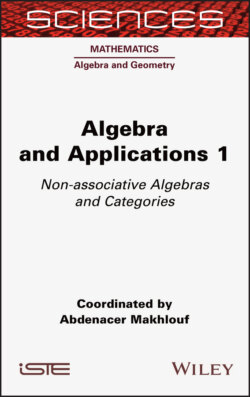Читать книгу Algebra and Applications 1 - Abdenacer Makhlouf - Страница 14
1.4. Brackets
ОглавлениеDEFINITION 1.10.– Let A be an associative commutative superalgebra. A binary map { , } : A × A → A is called a Poisson bracket if
1 1) (A, { , }) is a Lie superalgebra;
2 2) {ab, c} = a{b, c} + (–1)|b||c|{a, c}b for arbitrary .
EXAMPLE 1.16.– Let F[p1,…, pn, q1,…, qn] be a polynomial algebra in 2n variables. The classical Hamiltonian bracket:
is a Poisson bracket.
EXAMPLE 1.17.– Let
be the Grassmann algebra over an n-dimensional vector space V. Then the bracket
for arbitrary is a Poisson bracket.
DEFINITION 1.11.– Given an associative commutative superalgebra, a bilinear map { , } : A × A → A is called a contact bracket if:
1 i) (A, { , }) is a Lie superalgebra;
2 ii) {ab, c} = a{b, c} + (–1)|b||c|{a, c}b + abD(c) for arbitrary homogeneous elements a, b, c in A.
Note that a Poisson bracket is a contact bracket with D = 0.
EXAMPLE 1.18.– Let F[t] be the polynomial algebra. Then the bracket {f(t), g(t)} = f′(t)g(t) – f (t)g′(t) is a contact bracket.
EXAMPLE 1.19.– Let Λ(1 : n) be the polynomial superalgebra in one (even) Laurent variable and n (odd) Grassmann variables ξ1,…, ξn, Λ(1 : n) = F[t, t–1, ξ1,…, ξn]. Consider or a derivation of F[t, t–1]. The bilinear map defined on generators of Λ(1 : n) by:
can be extended to a contact bracket on Λ(1 : n).
DEFINITION 1.12.– [Kantor double] Let A be an associative commutative superalgebra with a bilinear map { , } : A × A → A. Assume that . Consider a direct sum of vector spaces KJ(A, { , }) = A + Av where |v| = 1. Define a new product in J(A, { , }) that coincides with the original one in A and is given by:
The superalgebra KJ(A, { , }) is called the Kantor double of (A, { , }).
Kantor (1990) proved that if the bracket { , } is a Poisson bracket, then KJ(A, { , }) is a Jordan superalgebra.
DEFINITION 1.13.– The bilinear map { , } is called a Jordan bracket on the superalgebra A if KJ(A, { , }) is a Jordan superalgebra (see King and McCrimmon (1992)).
Cantarini and Kac (2007) showed that there is a 1-1 correspondence between Jordan brackets and contact brackets. Indeed, if [a, b] is a contact bracket with derivation D, D(a) = [a, 1], then the new bracket
is a Jordan bracket.
Applying this to example 1.19, we get the following:
EXAMPLE 1.20.– The values {ξi, t} = 0, {ξi, ξj} = δij for 1 ≤ i, j ≤ n extend to a Jordan bracket of Λ(1 : n). Applying the Kantor double process to this bracket, we get Jordan superalgebras Jn = KJ(Λ(1 : n), { , }).
